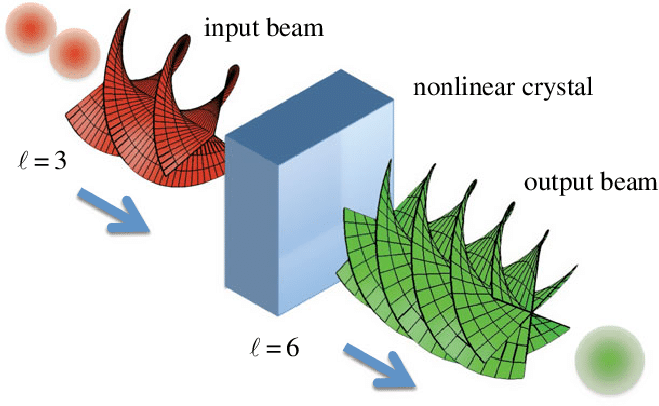In this post I want to share all types of non-linear crystals that are commonly used in laser industry.
The following crystals are mainly used for the second, third, fourth and fifth harmonic generation, called, SHG, THG, FHG.
Depending on the initial wavelength those crystals can absorb 2/3/4 photons and generate another photon (quant) with more energy. Usually, this process has not high efficiency.
For example, to get 532 nm wavelength photo you need 2 photons with 1064 nm wavelength. According to equation 1 photon with 532 nm carriers the same amount of energy as 2 photons with 1064 nm wavelength.
For example, to get 355 nm wavelength photo you need 2 photons with one with 1064 nm wavelength and a second with 532 energy. So combining both photons you get 355 nm wavelength photon.
The same for fourth and fifth harmonic generation.
KTP
Potassium titanyl phosphate (KTP) is an inorganic compound with the formula KTiOPO4. It is a white solid. KTP is an important nonlinear optical material that is commonly used for frequency-doubling diode-pumped solid-state lasers such as Nd:YAG and other neodymium-doped lasers.
Crystals of KTP are highly transparent for wavelengths between 350–2700 nm with a reduced transmission out to 4500 nm where the crystal is effectively opaque. Its second-harmonic generation (SHG) coefficient is about three times higher than KDP. It has a Mohs hardness of about 5.
The material has a relatively high threshold to optical damage (~15 J/cm²), an excellent optical nonlinearity and excellent thermal stability in theory. In practice, KTP crystals need to have the stable temperature to operate if they are pumped with 1064 nm (infrared, to output 532 nm green). However, it is prone to photochromic damage (called grey tracking) during high-power 1064 nm second-harmonic generation which tends to limit its use to low- and mid-power systems.
GTR-KTP (NLO)
KTA (Potassium Titanyle Arsenate – KTiOAsO4) is an excellent optical non-linear crystal mainly developed for Optical Parametric Oscillation(OPO).
OPO devices based on KTAs are reliable, solid-state sources of tunable laser radiation exhibiting energy conversion efficiencies above 50%. In addition, KTA has a very high damage threshold.
While being comparable to KTP in terms of non-linear efficiency and ease of use, the main advantage of KTA material over KTP lies in its significantly reduced absorption in the 3-4 µm range.
LBO
Lithium triborate (LiB3O5) or LBO is a non-linear optics crystal. It has a wide transparency range, moderately high nonlinear coupling, high damage threshold and desirable chemical and mechanical properties. This crystal is often used for second harmonic generation (SHG, also known as frequency doubling), for example of Nd:YAG lasers (1064 nm → 532 nm). LBO can be both critically and non-critically phase-matched. In the latter case the crystal has to be heated or cooled depending on the wavelength.
(An alternative for KPT crystals)
BiBO
BiB3O6 (BIBO) is a newly developed nonlinear optical crystal. It possesses large effective nonlinear coefficient, high damage threshold and inertness with respect to moisture. Its nonlinear coefficient is 3.5 – 4 times higher than that of LBO, 1.5 -2 times higher than that of BBO. It is a promising doubling crystal to produce blue laser.
KDP
Deuterated potassium dihydrogen phosphate (KD2PO4) or DKDP single crystals are widely used in non-linear optics as the second, third and fourth harmonic generators for Nd:YAG and Nd:YLF lasers. They are also found in electro-optical applications as Q-switches for Nd:YAG, Nd:YLF, Alexandrite, and Ti-sapphire lasers, as well as for Pockels cells.
DKDP is closely related to monopotassium phosphate or KDP or KH2PO4. Replacement of hydrogen by deuterium in DKDP lowers the frequency of O-H vibrations and their overtones (high-order harmonics). Absorption of light by those overtones is detrimental for the infrared lasers, which DKDP and KDP crystals are used for. Consequently, despite higher cost, DKDP is more popular than KDP.
DKDP crystals are grown by a water-solution method at usual level of deuteration >98%.
DKDP
Potassium Dideuterium Phosphate (KD*P, DKDP) crystals are amongst the most widely used nonlinear crystals. Both of these crystals are routinely used for the doubling, tripling, and quadrupling of Nd:YAG lasers at room temperatures. In addition, their excellent electro-optic coefficients mean that they are widely employed as EO modulators, Q-switches and Pockels cells.
Testing a KPT crystal from CASTECH
